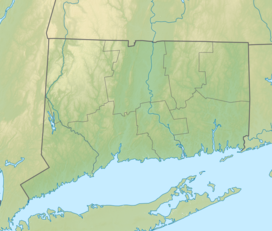Fowler Mountain
| Fowler Mountain | |
|---|---|

Fowler Mountain ridgeline from below
|
|
| Highest point | |
| Elevation | c. 750 ft (230 m) |
| Parent peak | 41° 26' 39"N, 72° 44' 25"W |
| Coordinates | 41°26′39″N 72°44′25″W / 41.44417°N 72.74028°WCoordinates: 41°26′39″N 72°44′25″W / 41.44417°N 72.74028°W |
| Geography | |
| Location | Durham and Wallingford, Connecticut |
| Parent range | Metacomet Ridge |
| Geology | |
| Age of rock | 200 Ma |
| Mountain type | Fault-block; igneous |
| Climbing | |
| Easiest route | Mattabesett Trail |
Fowler Mountain, est. 750 feet (230 m), is a traprock mountain located 7 miles (11 km) southeast of the center of Meriden, Connecticut. It is part of the narrow, linear Metacomet Ridge that extends from Long Island Sound near New Haven, Connecticut, north through the Connecticut River Valley of Massachusetts to the Vermont border. Fowler Mountain is known for its rugged topography, unique microclimate ecosystems, and rare plant communities. It rises steeply 300 feet (91 m) above the Ulbrich Reservoir and the Quinnipiac River valley to the west. The mountain is traversed by the 50-mile (80 km) Mattabesett Trail.
Located within the towns of Durham and Wallingford, Connecticut, Fowler Mountain is 1.2 miles (1.9 km) long by 0.5 miles (0.80 km) wide, although rugged topography makes the actual square mileage much larger. Fowler Mountain is an important aquifer; two reservoirs lie at the base of it: Ulbrich Reservoir to the west, in the town of Wallingford and Pistapaug Pond to the south, between Fowler Mountain and Pistapaug Mountain. The mountain is largely wooded with a few lookouts from rugged ledges over the reservoirs below.
The Metacomet Ridge continues north from Fowler Mountain as Trimountain and south as Pistapaug Mountain. The western half of Fowler Mountain drains into Muddy River, then into the Quinnipiac River, thence to Long Island Sound; the east side drains into the Coginchaug River, thence into the Connecticut River and Long Island Sound.
...
Wikipedia

